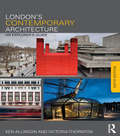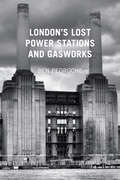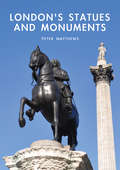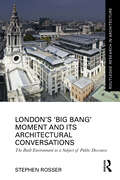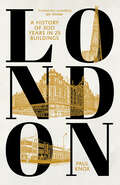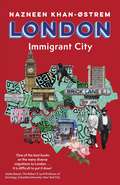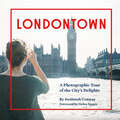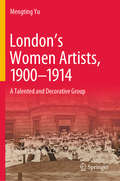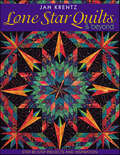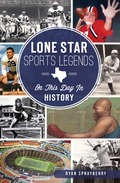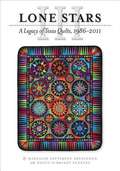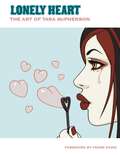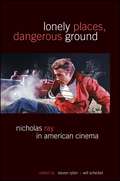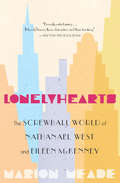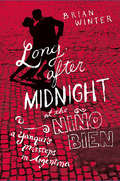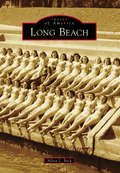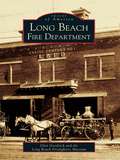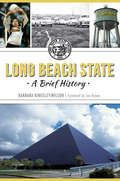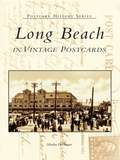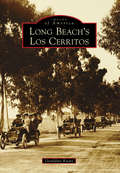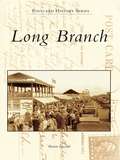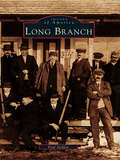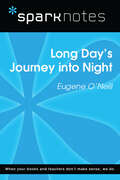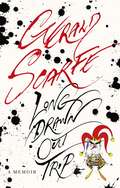- Table View
- List View
London's Contemporary Architecture: An Explorer's Guide
by Ken Allinson Victoria ThorntonLondon is a living architectural exhibition. This tried and trusted portable guide will help you to find your way around one of the world’s most exciting cities, offering architectural experiences and insights into London’s finest contemporary architecture. features more than 400 buildings including key venues from the 2012 Olympic Park provides a superb full colour photographic record of the capital aids navigation of the city’s greatest architectural sights with a clear map-based format considers each district in turn, identifying the buildings most worthwhile visiting, and providing essential information and insights into each includes a large scale, portable, lightweight map, for use when walking the tours Jam packed with the author’s intimate architectural experience and knowledge of London’s buildings, the accompanying commentary is both lively and entertaining, providing all the information that any architectural explorer will need to appreciate and experience London’s contemporary architecture.
London's Lost Power Stations and Gasworks
by Ben PedrocheMany of London’s original power stations have either been demolished, converted for other use, or stand derelict awaiting redevelopment that is seemingly always just out of reach. However, in their prime these mighty ‘cathedrals of power’ played a vital role in London’s journey towards becoming the world’s most important city. Gasworks also played a key role, built in the Victorian era to manufacture gas for industry and the people, before later falling out of favour once natural gas was discovered in the North Sea. London’s Lost Power Stations and Gasworks looks at the history of these great places. Famous sites that are still standing today, such as those at Battersea and Bankside (now the Tate Modern gallery), are covered in detail, but so are the previously untold stories of long-demolished and forgotten sites. Appealing to anyone with even the slightest interest in London, derelict buildings or urban exploring, this book uses London’s power supply as the starting point for a fascinating hidden history of Britain’s capital, and of the more general development of cities from the era of industrialisation to the present day.
London's Statues and Monuments
by Peter MatthewsThe streets and public spaces of London are rich with statues and monuments commemorating the great people of history. From the monumental Nelson's Column in Trafalgar Square and Sir Christopher Wren's Great Fire Monument to the charming Peter Pan statue in Kensington Gardens, and the bronze of Paddington Bear on the lawn of the railway station that gave him his name, the range of London's statues and monuments is huge. Some commemorate events, while others celebrate people, real and fictional. Some take the form of small reliefs, while others are huge pedimented bronzes, larger than life size. Executed in stone, bronze and a range of other materials, London's statues and monuments include work by some of the greatest sculptors.Shire first published a book on this subject in 1968, and for forty years it was a stalwart of the list, opening the eyes of countless Londoners and visitors to the capital to the sculptural splendour of the city. Peter Matthews has now produced an entirely new book on the subject, reorganised, rewritten, and reillustrated with a completely new set of specially taken photographs. Over 500 statues and monuments feature in this indispensible guide, and fascinating information about the sculptors and the stories behind the monuments make this book a uniquely useful resource for anyone wanting to gain a deeper insight into these wonderful adornments to the streets of the capital.
London's ‘Big Bang’ Moment and its Architectural Conversations: The Built Environment as a Subject of Public Discourse (Routledge Research in Architecture)
by Stephen RosserThis book explores the topic of architecture as a component of public discourse, focussing on the reception of four high-profile developments in the City of London (the UK capital’s financial district) dating from the final years of the twentieth century. During this time, the City’s mode of operation, culture and built environment were all transformed as a result of the market deregulation process labelled ‘Big Bang’. It was also a period which saw the subject of architecture attracting public and media attention, becoming a prominent feature of national conversation.The book examines the extensive and often contentious discourse generated by the four case study projects. It looks at how these projects were viewed and interpreted retrospectively, when they had become part of the City’s long and rich history. Topics explored include building and urban form on the eve of the millennium; the place of new development in a setting of unique historic importance; the ‘iconic’ building and ‘celebrity’ architect; and the role of (then) Prince Charles as an architectural critic. Also referenced are many of the broader issues of the day, including the Thatcher government policies and the preoccupations concerning London’s infrastructure, public realm, inner city areas and inequalities. Furthermore, ranging across the discourse is the theme of the relationship between buildings and global finance, foreshadowing later controversies concerning London’s post-millennial towers and their impact on the capital’s skyline.The book will be of interest to researchers and students of late-twentieth-century British architecture and urban development, London’s history and UK public discourse in the 1980s, a decade of profound political, economic and social change.
London: A History of 300 Years in 25 Buildings
by Paul KnoxA lively new history of London told through twenty-five buildings, from iconic Georgian townhouses to the Shard A walk along any London street takes you past a wealth of seemingly ordinary buildings: an Edwardian church, modernist postwar council housing, stuccoed Italianate terraces, a Bauhaus-inspired library. But these buildings are not just functional. They are evidence of London&’s rich and diverse history and have shaped people&’s experiences, identities, and relationships. In this engaging study, Paul L. Knox traces the history of London from the Georgian era to the present day through twenty-five surviving buildings. Knox explores where people lived and worked, from grand Regency squares to Victorian workshops, and highlights the impact of migration, gentrification, and inequality. We see famous buildings, like Harrods and Abbey Road Studios, and everyday places like Rochelle Street School and Thamesmead. Each historical period has introduced new buildings, and old ones have been repurposed. As Knox shows, it is the living history of these buildings that makes up the vibrant, but exceptionally unequal, city of today.
London: Immigrant City
by Nazneen Khan-ØstremTRANSLATED BY ALISON McCULLOUGH'One of the best books on the many diverse migrations to London . . . revealing the extent to which the diversity of immigrant origins has had transformative effects - through food, music, diverse types of knowledge and so much more. The book is difficult to put it down'Saskia Sassen, The Robert S. Lynd Professor of Sociology, Columbia University, New York'The ultimate book about Great Britain's capital'Dagbladet'One of the best books of the year! . . . This is a book about what a city is and can be'AftenpostenIs there a street in London which does not contain a story from the Empire? Immigrants made London; and they keep remaking it in a thousand different ways. Nazneen Khan-Østrem has drawn a wonderful new map of a city that everyone thought they already knew. She travels around the city, meeting the very people who have created a truly unique metropolis, and shows how London's incredible development is directly attributable to the many different groups of immigrants who arrived after the Second World War, in part due to the Nationality Act of 1948. Her book reveals the historical, cultural and political changes within those communities which have fundamentally transformed the city, and which have rarely been considered alongside each other.Nazneen Khan-Østrem has a cosmopolitan background herself, being a British, Muslim, Asian woman, born in Nairobi and raised in the UK and Norway, which has helped her in unravelling the city's rich immigrant history and its constant ongoing evolution.Drawing on London's rich literature and its musical heritage, she has created an intricate portrait of a strikingly multi-faceted metropolis. Based on extensive research, particularly into aspects not generally covered in the wide array of existing books on the city, London manages to capture the city's enticing complexity and its ruthless vitality.This celebration of London's diverse immigrant communities is timely in the light of the societal fault lines exposed by the Covid-19 pandemic and Brexit. It is a sensitive and insightful book that has a great deal to say to Londoners as well as to Britain as a whole.
London: Immigrant City
by Nazneen Khan-ØstremTRANSLATED BY ALISON McCULLOUGH'One of the best books on the many diverse migrations to London . . . revealing the extent to which the diversity of immigrant origins has had transformative effects - through food, music, diverse types of knowledge and so much more. The book is difficult to put it down'Saskia Sassen, The Robert S. Lynd Professor of Sociology, Columbia University, New York'The ultimate book about Great Britain's capital'Dagbladet'One of the best books of the year! . . . This is a book about what a city is and can be'AftenpostenIs there a street in London which does not contain a story from the Empire? Immigrants made London; and they keep remaking it in a thousand different ways. Nazneen Khan-Østrem has drawn a wonderful new map of a city that everyone thought they already knew. She travels around the city, meeting the very people who have created a truly unique metropolis, and shows how London's incredible development is directly attributable to the many different groups of immigrants who arrived after the Second World War, in part due to the Nationality Act of 1948. Her book reveals the historical, cultural and political changes within those communities which have fundamentally transformed the city, and which have rarely been considered alongside each other.Nazneen Khan-Østrem has a cosmopolitan background herself, being a British, Muslim, Asian woman, born in Nairobi and raised in the UK and Norway, which has helped her in unravelling the city's rich immigrant history and its constant ongoing evolution.Drawing on London's rich literature and its musical heritage, she has created an intricate portrait of a strikingly multi-faceted metropolis. Based on extensive research, particularly into aspects not generally covered in the wide array of existing books on the city, London manages to capture the city's enticing complexity and its ruthless vitality.This celebration of London's diverse immigrant communities is timely in the light of the societal fault lines exposed by the Covid-19 pandemic and Brexit. It is a sensitive and insightful book that has a great deal to say to Londoners as well as to Britain as a whole.
Londontown: A Photographic Tour of the City's Delights
by Susannah ConwayLondontown is a love letter in pictures to this bustling world capital. Photographer Susannah Conway takes us beyond the familiar sights to capture an authentic local experience of the city. Readers will travel with her as she crisscrosses London, shooting all the hippest, most exciting, and most historic neighborhoods, and sampling the city's effortless cool, vibrant street life, and timeless know-how. Mixing signature Polaroid shots with modern digital photos, this insider's slice of London life will appeal both to those living half a mile from Big Ben and Anglophiles anywhere.
London’s Women Artists, 1900-1914: A Talented and Decorative Group
by Mengting YuDrawing on untapped archives, as well as aggregating a wide range of existing published sources, this book recalibrates the understanding of women artists’ roles, outputs and receptions in London during what was indubitably a vibrant and innovative period in the history of British art, and in which the work of their male contemporaries is so well understood. The book takes its starting point from Alicia Foster’s article “Gwen John’s Self-Portrait: Art, Identity and Women Students at the Slade School,” published in 2000, where the expression “a talented and decorative group” was coined to describe common attitudes towards women artists in the late 19th and early 20th century London. This pejorative attribution strongly implied a status less significant to that of their male counterparts. The author challenges this statement's basic tenet by casting a wide net in examining women’s art education from the Slade School of Fine Art, through to the role of its graduates within a selection of London’s exhibition groups, societies and publications. This book also reconstructs ‘from scratch’ the role of the Women’s International Art Club (WIAC), hitherto entirely overlooked in art historical studies of the era. This book will be of interest to students and researchers in art and cultural history, gender studies,and in sociological studies of pre-War World War Britain.
Lone Star Quilts & Beyond: Step-by-Step Projects and Inspiration
by Jan KrentzExplore the world of Lone Star quilts! Expert teacher Jan Krentz shows you how to use today’s techniques to simplify this intricate design. • 6 colorful projects - you’ll want to get started right away! • Rotary cutting saves you time, while imaginative additions such as appliqué and “designer diamonds” give these Lone Stars a fresh, updated look • Jan teaches you everything you’ll need to know to make the Lone Star quilt of your dreams, from fabric choices to finishing touches. • A gallery of eye-catching Lone Star quilts to inspire your creativity *Important Note about PRINT ON DEMAND Editions: This title will be printed after purchase and will arrive separately from any in-stock items. Please allow approximately 2 weeks for USA delivery, with an additional 2 weeks for international shipments. Expedited shipping is not available on POD Editions. The printing quality in this copy will vary from the original offset printing edition and may look more saturated due to printing on demand by a high-quality printer on uncoated (non-glossy) paper. The information presented in this version is the same as the most recent printed edition. Any pattern pullouts have been separated and presented as single pages.
Lone Star Sports Legends: On This Day in History (On This Day In)
by Ryan SprayberryFrom the clash of college to the best married shooting duo in history, the Lone Star State clears every hurdle the sports world offers. A former Texas Christian basketball player became the first tenured African American professor at Harvard Business School. Aggie football legend John Kimbrough�s first professional contract required him to act in movies and serve as the stadium�s handyman. For every date on the calendar, Ryan Sprayberry provides a play-by-play of 365 memorable days in the state�s athletic history, beginning with the birth of the Cotton Bowl on January 1, 1937, and ending with the final snap of the Ice Bowl on December 31, 1967.
Lone Stars III
by Bresenhan Karoline Patterson Puentes Nancy O'BryantThis volume, which covers 1986-2011, completes the landmark documentation of 175 years of Texas quilt history that the authors began in Lone Stars I and II.
Lonely Heart: The Art of Tara McPherson Volume 1
by Tara McPhersonThe compelling paintings and posters of Tara McPherson are a tour de force of creative tension, at once heartfelt and heartbreaking. Creating art about people and their odd ways, recalling many issues from childhood and adult life experience, McPherson creates images that are thought provoking and seductive. Tara's array of work includes numerous gig posters for rock bands, including Green Day, Modest Mouse, and Death Cab for Cutie, and advertising and editorial illustrations for a diverse group of clients. Her prints and paintings have been exhibited in galleries all over the world. Lonely Heart is the first printed collection of McPherson's work.• Foreword by Frank Kozik!• This collection features full-color illustrations throughout.
Lonely Places, Dangerous Ground: Nicholas Ray in American Cinema (SUNY series, Horizons of Cinema)
by Steven Rybin; Will ScheibelThe director of such classic Hollywood films as In a Lonely Place, Johnny Guitar, and Rebel Without a Cause, Nicholas Ray nevertheless remained on the margins of the American studio system throughout his career, and despite his cult status among auteurist critics and cinephiles, he has also remained at the margins of film scholarship. Lonely Places, Dangerous Ground offers twenty new essays by international film historians and critics that explore the director's place in the history of the Hollywood industry and in the larger institution of cinema, as well as a 1977 interview with Ray that has never before been published in its entirety in English. In addition to readings of Ray's most celebrated films, the book provides a range of approaches to his life and work, engaging new questions of his cinematic authorship with areas that include history and culture, politics and society, gender and sexuality, style and genre, performance, technology, and popular music. The collection also looks at Ray's lesser-known and underappreciated films, and devotes attention to the highly experimental We Can't Go Home Again, his recently restored final film made in the 1970s with his students at Binghamton University, State University of New York. Rediscovering what Ray means to contemporary film studies, the essays show how his films continue to possess a vital power for film history and criticism, and for film culture.
Lonelyhearts: The Screwball World of Nathanael West and Eileen McKenney
by Marion MeadeA &“breezily entertaining&” look at the comic couple who hobnobbed with Dorothy Parker, S. J. Perelman, Bennett Cerf, and other luminaries of their day (The New York Times Book Review). Nathanael West—author, screenwriter, playwright—was famous for two masterpieces: Miss Lonelyhearts and The Day of the Locust, which remains one the most penetrating novels ever written about Hollywood. He was also one of the most gifted and original writers of his generation, a scathing satirist whose insight into the brutalities of modern life proved prophetic. Eileen McKenney—accidental muse, literary heroine—grew up corn-fed in the Midwest and moved to Manhattan&’s Greenwich Village when she was twenty-one. The inspiration for her sister Ruth&’s stories in the New Yorker under the banner of &“My Sister Eileen,&” she became an overnight celebrity, and her star eventually crossed with that of the man she would impulsively marry. Together, Nathanael and Eileen had entrée into a social circle that included F. Scott Fitzgerald, Dashiell Hammett, Katharine White, and many of the literary, theatrical, and film luminaries of the era. But their carefree, offbeat Broadway-to-Hollywood love story would flame out almost as soon as it began. Now, with &“a great marriage of scholarship and gossip&” (Minneapolis Star-Tribune), this biography restores West and McKenney to their rightful place in the popular imagination, offering &“a shrewd portrait of two people who in their different ways were noteworthy participants in American culture during one of its liveliest periods&” (Los Angeles Times). &“Opens a window onto the lives of writers in 1930s America as they struggled with anxieties, pretensions, temptations and myths that confound our culture to this day.&” —Salon.com &“The first to fully chronicle and entwine these careening lives, Meade forges an engrossing, madcap, and tragic American story of ambition, reinvention, and risk.&” —Booklist, starred review
Long After Midnight at the Nino Bien: A Yanqui's Missteps in Argentina
by Brian WinterAfter moving to Argentina on a whim, Brian Winter, a young American reporter, embarks on a crusade to learn that devilishly difficult dance that demands both discipline and passion: the tango. While he dances the night away in the milongas with the fiery denizens of Buenos Aires, the country around them collapses, gripped by inflation, street riots, and revolution. In a book that is part travelogue and part history, the author evokes his immersion in a dark underworld. He visits old dance salons, brothels, and shacks on the dusty Pampa, searching for the tango's shady origins in the hope that understanding may help him dance better. Along the way, he discovers that the tango, with its tales of jealousy, melodrama, and lost glory, may hold the secret to the country that is inexplicably disintegrating before his eyes.
Long Beach
by Allisa L. BeckLong Beach, Mississippi, was once known as the "radish capital of America." The famous long reds were grown in the fertile soil of the area and were shipped to all points north to be served alongside drinks in beer halls. From the town's incorporation in 1905 through the 1920s, Long Beach was a hub of the truck farming industry. Along with the famous radishes, growers cultivated pear, citrus, and pecan orchards, fields of strawberries, and other produce. Nurseries that produced lilies and gladiolas also thrived. Although the truck farming boom ended, Long Beach has continued to grow, today relying on the tourists that visit the Gulf Coast for the beautiful sandy beaches and Southern hospitality. The city has been devastated by hurricanes in its long history, from the first documented hurricane of 1909 through Hurricane Katrina, but it has persevered and continues to survive. Long Beach richly deserves its motto as the "Friendly City."
Long Beach Fire Department (Images of America)
by Long Beach Firefighters Museum Glen GoodrichThe Long Beach Fire Department's adaptability has been tested by a wide variety of disasters that have marked it as a unique firefighting force on the West Coast. Thousands of residents and others have owed their very lives to thedepartment since its 1897 formation. The LBFD moved into action during the devastating 1933 Long Beach earthquake, in which its own Fire House No. 1 was reduced to rubble. Itsfirefighters have quelled oilfield blazes through the 20th century, and its fireboats have poured water onto flames engulfing the docks and warehouses of the bustling port. Other duties have included such side excursions as workingstandby during Howard Hughes's 1947 flight of the Spruce Goose and taking care of Sam the cat, a Station 6 mainstay who slid down the fire pole to the delight of television audiences.
Long Beach State: A Brief History (Brief History)
by Barbara Kingsley-Wilson Lee BrownLong Beach State grew up right along with the sprawling Southern California suburbs. Born in 1949, it swelled to accommodate the post-world war enthusiasm for education and land. The rapid expansion brought its share of growing pains. Students took classes in a cramped converted apartment with no books and playing ring-around-the-rosie for physical education. Money was scarce, and faculty at times feuded with the administration. But the new college's "let's put on a show" spirit produced a scrappiness that endures today. Read about the personalities that grew the college from Fred Bixby's bean fields into one of the largest universities in California.
Long Beach in Vintage Postcards (Postcard History)
by Marlin HeckmanLong Beach successfully incorporated as a city in 1888, and would eventually become California's fifth largest city. Author Marlin Heckman has compiled over 200 vintage postcards to chronicle the history of the "Queen of Beaches." Competition between the Santa Fe and Southern Pacific Railroads brought great numbers of visitors to Southern California at the turn of the century. Resort hotels, apartments, pavilions, and band shells quickly dotted the landscape to accommodate the massive influx of tourists. Seen here are the more famous Long Beach attractions, including Rainbow Pier, the Sun Pavilion, the Hotel del Mar, and the great "Walk of a Thousand Lights," or the Pike, as it was better known.
Long Beach's Los Cerritos
by Geraldine KnatzEvolving from a 27,000-acre rancho, to a colony of farmers, and then to a neighborhood subdivision, Long Beach's Los Cerritos is the story of a fiercely independent community established prior to William Willmore's vision of a city of Long Beach took hold. Life centered around the historic Rancho Los Cerritos throughout the 19th and early 20th centuries as John Temple's cattle ranching was replaced by Jotham Bixby's sheep ranching and tenant farming operations. Jotham Bixby sold off land for small farms to create the Cerritos Colony, and further subdivided land to create the Los Cerritos neighborhood. Invaded by oil drilling rigs after the discovery of oil in nearby Signal Hill, fires and noise caused the residents to flee. Los Cerritos declined but rebounded in the 1930s, aided by the presence of the Virginia County Club, stately homes designed by world-renowned architects, and the restoration of the historic rancho adobe by the Bixby family.
Long Branch
by Sharon HazardIn days gone by, Long Branch was filled with the mansions of millionaires, a business district bustling with commerce, and an oceanfront dotted with glittering gambling casinos and the finest hotels. At the dawn of the 20th century, everyone flocked to Ocean Avenue, either as a resident or visitor just taking in the sights. Some of these people were well-known actors, politicians, and business tycoons of the day. Others were day-trippers here to enjoy the cool breezes and summer entertainment that Long Branch had to offer. Some local citizens worked in the city, helping to maintain its reputation as the premier summer resort in the nation--a distinction bestowed by Mary Todd Lincoln when she visited in the summer of 1861. Many people came to Long Branch for many reasons, but all of them had one thing in common, the important role they played in its proud past.
Long Branch (Images of America)
by Paul SniffenLong Branch is one of the greatest nineteenth-centuryAmerican cities. For decades it was the premier summer resort in the Northeast, and a list of visitors to the area reads like a Who's Who of the nineteenth century: Presidents Arthur, Garfield, Grant, Hayes, Harrison, McKinley, and Wilson all vacationed here, as well as Diamond Jim Brady, Lillian Russell, General Winfield Scott, Henry Ward Beecher, "Buffalo" Bill Cody, Horace Greeley, and General George Meade. Leaders in fashion, finance, theater, politics, and the military flocked to Long Branch by the hundreds because of its tremendous natural beauty, Victorian mansions and hotels, and proximity to New York, Philadelphia, and Washington, D.C.
Long Day's Journey Into Night (SparkNotes Literature Guide Series)
by SparkNotesLong Day's Journey Into Night (SparkNotes Literature Guide) by Eugene O'Neill Making the reading experience fun! Created by Harvard students for students everywhere, SparkNotes is a new breed of study guide: smarter, better, faster. Geared to what today's students need to know, SparkNotes provides: *Chapter-by-chapter analysis *Explanations of key themes, motifs, and symbols *A review quiz and essay topicsLively and accessible, these guides are perfect for late-night studying and writing papers
Long Drawn Out Trip: A Memoir
by Gerald ScarfeIn Long Drawn Out Trip: My Life, Gerald Scarfe tells his life story for the first time. With captivating, often thrilling stories, he takes us from his childhood and early days at Punch and Private Eye, through his long and occasionally tumultuous career as the Sunday Times cartoonist, to his film-making at the BBC and much-loved designs for Pink Floyd's The Wall and Disney's Hercules. Along the way he has drawn Churchill from life, gone on tour with The Beatles and thoroughly upset Mrs Mary Whitehouse. It is a very personal, wickedly funny and caustically insightful account of an artist's life at the forefront of contemporary culture and society.
